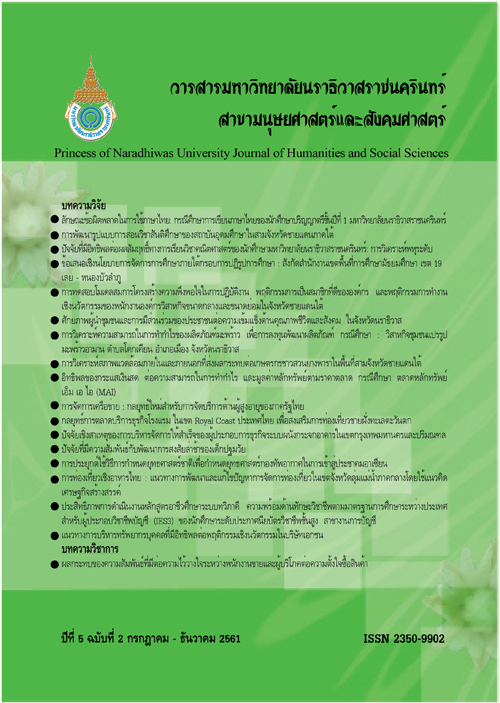การจัดการเครือข่าย : กลยุทธ์ใหม่สำหรับการจัดบริการด้านผู้สูงอายุของภาครัฐไทย
Main Article Content
Abstract
การวิจัยนี้มีวัตถุประสงค์เพื่อพัฒนาแบบจำลองสมการโครงสร้างของการจัดการเครือข่ายงานบริการด้านผู้สูงอายุในภาคใต้ มีหน่วยการวิเคราะห์ระดับองค์กร เป็นการวิจัยเชิงปริมาณ กำหนดขนาดกลุ่มตัวอย่างเป็น 556 ตัวอย่างจาก การวิจัยนี้มีวัตถุประสงค์เพื่อพัฒนาแบบจำลองสมการโครงสร้างของการจัดการเครือข่ายงานบริการด้านผู้สูงอายุในภาคใต้ มีหน่วยการวิเคราะห์ระดับองค์กร เป็นการวิจัยเชิงปริมาณ กำหนดขนาดกลุ่มตัวอย่างเป็น 556 ตัวอย่างจาก
หน่วยงานที่มีหน้าที่หลักในการจัดบริการด้านผู้สูงอายุในภาคใต้ ทำการสุ่มตัวอย่างแบบหลายขั้นตอน เก็บรวบรวมข้อมูลโดยแบบสอบถาม มีค่าสัมประสิทธิ์แอลฟาเท่ากับ 0.938 วิเคราะห์ข้อมูลโดยใช้โปรแกรมสำเร็จรูป LISREL Version 8.8 ผลการวิจัยพบว่า แบบจำลองสมการโครงสร้างของการจัดการเครือข่ายงานบริการด้านผู้สูงอายุในภาคใต้มีความสอดคล้องกับข้อมูลเชิงประจักษ์ (X2=767.53, df=279, RMSEA=0.064, CFI=0.98, SRMR=0.058) ปัจจัยที่มีอิทธิพลทางตรง
เชิงบวกต่อผลการดำเนินงานของการจัดการเครือข่ายมากที่สุดคือ ความไว้วางใจ รองลงมา คือ การมีส่วนช่วยเหลือแบ่งปันทรัพยากรร่วมกัน ระบบปฏิสัมพันธ์ทางสังคม และการบริหารงาน โดยมีค่าสัมประสิทธิ์อิทธิพล เท่ากับ 0.41 0.26 0.19และ
0.18 ตามลำดับ สำหรับปัจจัยที่มีอิทธิพลทางตรงเชิงลบต่อผลการดำเนินงานของการจัดการเครือข่าย คือ ความเป็นอิสระของหุ้นส่วน โดยมีค่าสัมประสิทธิ์อิทธิพล เท่ากับ -0.08 ขณะที่ปัจจัยเหตุที่มาของเครือข่ายไม่มีอิทธิพลทางตรงต่อผลการดำเนิน
งานของการจัดการเครือข่าย แต่จะมีอิทธิพลทางอ้อมโดยมีตัวแปรส่งผ่าน คือ ความไว้วางใจ
Article Details
References
ครั้งที่ 2). กรุงเทพฯ: สำนักพิมพ์แห่งจุฬาลงกรณ์มหาวิทยาลัย.
2.นารีรัตน์ จิตรมนตรี, และสาวิตรี ทยานศิลป์. (2551) รายงานวิจัยฉบับสมบูรณ์ การทบทวนองค์ความรู้และแนวทางการจัด
ระบบสวัสดิการผู้สูงอายุในประเทศไทย. กรุงเทพฯ: สำนักงานกองทุนสนับสนุนการสร้างเสริมสุขภาพ (สสส).
3.พิชาย รัตนดิลก ณ ภูเก็ต. (2556). จากปัญหาสู่นโยบาย: ศึกษากรณีผู้สูงอายุในจังหวัดชายแดนภาคใต้. วารสารร่มพฤกษ์,
31(3), 1-26.
4.มูลนิธิสถาบันวิจัยและพัฒนาผู้สูงอายุไทย (มส.ผส.), และสถาบันวิจัยประชากรและสังคม มหาวิทยาลัยมหิดล. (2559).
สถานการณ์ผู้สูงอายุไทย พ.ศ.2558. กรุงเทพฯ: อมรินทร์พริ้นติ้งแอนด์พลับชิง.
5.วีระศักดิ์ เครือเทพ. (2550). เครือข่าย: นวัตกรรมการทำงานขององค์กรปกครองส่วนท้องถิ่น. กรุงเทพฯ: ซีโนดีไซน์.
6.Agranoff, R., & McGuire, M. (2003). Collaborative public management: New strategies for local governments.
Washington, D.C.: Georgetown University Press.
7.Babbie, E. (2002). The basics of social research. (2nd ed.). Belmont, CA: Wadsworth.
8.Chen, B. (2010). Antecedents or processes? Determinants of perceived effectiveness of interorganizational
collaborations for public service delivery. International Public Management Journal, 13(4), 381-407.
9.Fryxell, G. E., Dooley, R. S., & Vryza, M. (2002). After the ink dries: the interaction of trust and control in
U.S.-based international joint ventures. Journal of Management Studies, 39(6), 865-886.
10.Getha-Taylor, H. (2012). Cross-sector understanding and trust. Public performance & management review, 36(2),216-229.
11.Gray, B., & Ren, H. (2014). The importance of joint schemas and brokers in promoting collaboration for
innovation. In C. Ansell & J. Torfing (Eds.), Public Innovation Through Collaboration and Design.
New York: Routledge.
12.Hair, J.F., Black, W.C., Babin, B.J., & Anderson, R.E. (2010). Multivariate data analysis (7th ed.). Upper
Saddle River, NJ: Prentice Hall.
13.Hellriegel, D., Slocum, J. W., & Woodman, R. W. (2010). Organization behavior (13th ed.). OH: South-Western
Cengage Learning.
14.Hovik, S., & Hanssen, G. S. (2015). The impact of network management and complexity on multi-level
coordination. Public administration, 93(2), 506-523.
15.Huang, K. (2014). Knowledge sharing in a third-party-governed health and human services network. Public
Administration Review, 74(5), 587-598.
16.Huang, K., & Provan, K. G. (2007). Structural emeddedness and organizational social outcomes in a centrally
governed mental he alth sevices network. Public Management Review, 9(2), 169-189.
17.Keast, R., & Waterhouse, J. (2014). Collaborative networks and innovation:the negotiation-management
nexus. In C. Ansell & J. Torfing (Eds.), Public Innovation Through Collaboration and Design.
NewYork: Routledge.
18.Kim, N., & Cho, W. (2014). Agencification and performance: The impact of autonomy and result-control on
the performance of executive agencies in Korea. Public Performance & Management Review,
38(2), 214-233.
19.Klijn, E.-H., Edelenbos, J., & Steijn, B. (2010). Trust in governance networks; its impacts on outcomes.
Administration and Society, 42(2), 1-23.
20.Kline, R. B. (2011). Principles and practice of structural equation modeling. (3rd ed.). New York: The Guilford
Press.
21.Lui, S. S., & Ngo, H.-y. (2004). The role of trust and contractual safeguards on cooperation in non-equity
alliances. Journal of Management, 30(4), 471-485.
22.Meerkerk, I., & Edelenbos, J. (2014). The effects of boundary spanners on trust and performance of urban
governance networks: findings from survey research on urban development projects in the
Netherlands. Policy Sciences, 47(1), 3-24.
23.Mollering, G. (2006). Trust: Reason, routine, reflexivity. Amsterdam: Emerald Group Publishing.
24.O'Toole, J. L. J. (1997). Treating networks seriously: practical and research-based agendas in public
administration. Public Administration Review, 57(1), 45-52.
25.Page, S. B., Stone, M. M., Bryson, J. M., & Crosby, B. C. (2015). Public value creation by cross-sector
collaborations: A framework and challenges of assessment. Public administration, 93(3), 715-732.
26.Pfeffer, J., & Salancik, G. R. (1978). The external control of organizations: A resource dependence
perspective. Stanford: Stanford University Press.
27.Popp, J., MacKean, G. L., Casebeer, A., Milward, H. B., & Lindstrom, R. R. (2013). Inter-organizational net
works: A critical review of the literature to Inform practice
28.Ring, P. S., & Van de Ven, A. H. (1994). Developmental processes of cooperative interorganizational
relationships. Academy of Management Review, 19(1), 90-118.
29.Romzek, B. S., LeRoux, K., & Blackmar, J. M. (2012). A preliminary theory of informal accountability among
network organizational actors. Public Administration Review, 72(3), 442-453.
30.Sen, A. K. (1997). Choice, welfare and measurement. Cambridge, Mass: Harvard University Press.
31.Thomson, A. M. (2001). Collaboration: Meaning and measurement (Doctoral dissertation). Available from
ProQuest Dissertations and Theses database. (UMI No. 3038517)
32.Turrini, A., Cristofoli, D., Frosini, F., & Nasi, G. (2010). Networking literature about determinants of network
effectiveness. Public Administration, 88(2), 528-550.
32.Van de Ven, A. H., & Walker, G. (1984). The dynamics of interorganizational coordination. Administrative
science quarterly, 29(4), 598-621.
33.Varda, D. M., & Retrum, J. H. (2015). Collaborative performance as a function of network members
perceptions of success. Public performance & Management Review, 38(4), 632-653.


